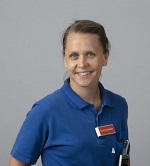ESTRO 2023: Brachytherapy Track
Report from a Medical Physicist’s perspective
The brachytherapy track at this year's ESTRO congress had many interesting items and sometimes different sessions to choose from. I think the programme suited the whole brachytherapy team. Here I give a brief overview of what I, as a medical physicist, thought were the highlights of the brachytherapy track at ESTRO 2023.
I will start with the debate about centralisation in brachytherapy. Ann Henry and Jean-Michel Hannoun-Levi worked very well to convince the audience to vote for their opinion. Many different aspects of brachytherapy were brought to light, such as patient-focused treatments, the teamwork technical skills and education required to perform it, and its declining use. At the end, the audience joined the discussion. The session was planned well to ensure that there was enough time for this contribution to the debate. The main points were that brachytherapy is a complex treatment that demands much from the team working with it, but that also knowledge of it must be spread so that it will remain an important tool in radiation therapy. It was an even debate and, by the conclusion, 60% of the voters were against the centralisation of brachytherapy.
Automisation in radiotherapy was a topic that was presented in many sessions throughout the different tracks of the congress, including the brachytherapy track. Luca Tagliaferri presented a talk on artificial intelligence (AI) and data handling, and Tanja Alderliesten continued with a presentation about how AI could be used in treatment planning. Cédric Bélanger reported on his team’s work on multi-criteria optimisation in brachytherapy and the session was ended by Danique Barten, who shared her research group’s experience of the implementation of an automated treatment planning tool, which the group had developed, in the clinic. The researchers’ work has given them knowledge of what is missing from the optimisation criteria, such as the location of high-dose sub-volumes. These high-dose sub-volumes were the cause of additional manual adjustments of their automatically created treatment plans.
In the session “Risk-adapted personalised brachytherapy”, Maximilian Schmid gave the background to the creation of the third stage of the study of image-guided, externally modulated, external beam radiochemotherapy and MRI-based adaptive brachytherapy in locally advanced cervical cancer (EMBRACE-lll). This third stage is divided into five parts: high risk, low risk, MRI registration, CT registration and oligometastatic. It will be interesting to follow these studies as they progress. Supriya Chopra presented some early results from the BIOEMBRACE study, in which the local control of different histological types of cervical cancer is under investigation. The session ended with a talk by Charlotte Robert about non-invasive tumour characterisation.
The sessions on proffered papers were also very interesting. I chose to listen to “gynaecology”, “physics” and “head & neck and physics”. My favourite was the gynaecology session as at the moment most of my work is on this treatment site. Monica Serban presented an analysis of the data collected in the EMBRACE-I project, in which researchers studied the morbidity and local control of cervical cancer in patients according to which type of applicator was used (ring or ovoids). They found similar local control with both applicators, but the risk of morbidity was on average higher when ovoids were used. Alexandra Rink reported on dosimetric risk factors for vaginal toxicity among cervical cancer patients. They found that vaginal doses were correlated with the risk of physician-reported vaginal toxicity and patient-reported outcomes. In this session, the Groupe Européen de Curiethérapie (GEC)-ESTRO best junior presentation was made. The presentation explained a tool (EviGuide) that could aid the choice of treatment plan for cervical cancer. Instead of an Excel data sheet, this program can be used; dose-volume histogram data are uploaded, and the treatment plan is compared with the EMBRACE-I study data. The tool provides the user with knowledge about how to balance target coverage and organ-at-risk sparing and how this will affect the treatment outcome and morbidity.
These were some of the highlights, from a medical physicist’s point of view, in the brachytherapy track of ESTRO 2023, which took place in Vienna, Austria, in May.

Frida Dohlmar
Medical Physicist, PhD student
Linköping University Hospital,
Linköping, Sweden